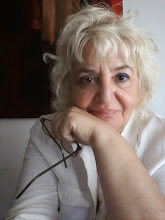 ™ NIRAM ART
™ NIRAM ARTA Ñ O I I , N º 7 ▪ F E B R E R O 2 0 0 7
MARIA JOÃO FRANCO
PORTUGAL
Director: Rares Stejar Noaghiul Barbulescu
Multilingüe
.....................................
María João Franco: In between the Silence of the Bodies and
the Whisper of its Representation........Rocha de Sousa
How to Explain the Unexplainable?.........José Jorge Letria
Flowers of Mould.............Bianca Marin
One of the most amazing similarities lies in the comparison of Baudelaire’s poems “The Cat” (inspired by Edgar Allen Poe’s Tales of Mystery and Imagination, where he saw Poe’s use of fantasy as a way of emphasizing the mystery and tragedy of human existence) and Maria João Franco’s painting “The Dog”. In two separate poems, both entitled "The Cat", the poet is horrified to see the eyes of his lover in a black cat whose chilling stare, "profound and cold, cuts and cracks like a sword."( “Je vois avec étonnement/ Le feu de ses prunelles pâles,/ Clairs fanaux, vivantes opales/Qui me contemplent fixement). In “The Dog” the same terror is provoked by the big, stout dog with its face directed to a river of blood, and one can easily distinguish the form of a human face appearing in the lieu of the dog’s head. It is as if Baudelaire’s verses came to life in images, it is sheer Baudelaire poetry on canvas.

Moreover in “The Laying woman”(Deitada), a feminine figure seems to be sleeping or lying dead, her body torn into hundreds of little atoms, reduced to small, dispersed fragments, traces of paint flowing from her like drops of water. It is yet another example of how beauty can reside
even in the most horrible moments. The image created by the irregularity of the forms and the chaos of the splashes of paint is so beautiful that it seems as if flowers were growing out of her decaying body, the fertilizing territory of human flesh. Flowers of putrefaction, flowers of mould, the Romanian poet Tudor Arghezi would say. Maria João Franco makes caresses out of open wounds, “out of furuncles, moulds and mud” (Tudor Arghezi, “Testament” from the Volume of Poetry “Flowers of Mould”) she creates new beauties and treasures.
Maria João Franco is not obsessed with the ugliness or the pain. She accepts all the aspects of humanity, even the most infamous, because, as I said before, this may be the only way to extinguish them. The objective of her paintings is not to shock, but to heal. Her love for the human being is such, that its physical decay hurts her to the extent of endlessly trying to conquer it. It is a painful, deep love for the transient human body in all its circumstances, even in death. We can hear Maria João Franco’s voice speaking to us through the words of the poet Lucian Blaga in his poetic statement“I Will not Crush the World’s Corolla of Wonders ”: “I enrich the darkening horizon with chills of the great secret. All that is hard to know becomes a greater riddle under my very eyes becausI love alike flowers, lips, eyes, and graves”.
In order to understand a painting, we should look at it with eyes of a poet. It is easy to recognize fragments of Maria João Franco’s paintings in the verses of a poem. I tried to present here her paintings as seen through the verses of three poets that explain them better than any critical essay. There are no boundaries in art, and it would be no wonder if some day a poet would find inspiration in one of Maria João Paintings to create his or her own poetry.
"- Mon beau chien, mon bon chien, mon cher toutou, approchez et venez respirer un excellent parfum acheté chez le meilleur parfumeur de la ville."

Et le chien, en frétillant de la queue, ce qui est, je crois, chez ces pauvres êtres, le signe correspondant du rire et du sourire, s’approche
et pose curieusement son nez humide sur le flacon débouché; puis, reculant soudainement avec effroi, il aboie contre moi, en manière de reproche. "- Ah! misérable chien, si je vous avais offert un paquet d’excréments, vous l’auriez flairé avec délices et peut-être dévoré. Ainsi, vous-même,indigne compagnon de ma triste vie, vous ressemblez au public, à qui il ne faut jamais présenter des parfums délicats qui l’exaspèrent, mais des ordures soigneusement choisies."
(Charles Baudelaire)
About the state of struggling by Nichita Stanescu As though the superior knife edge had cut my clouds from the mountain tops does my immense and headless body hurl itself about,leaving its fugitive head in the sky. It cannot die though it no longer knows what its own life meant, in ages past.
The eye above observes the body below, its struggling . From the open throat a flock of green and chirping birds wells up
- The hand thrusts its claws into the mirage
- The eye, suspended, watches the desperate struggle (…)
Bianca Marin
-English translation by Thomas Carlson and Vasile Poenaru.
_______________________________________________________
Pintar, raras vezes foi, como agora, um acto de febril magia, uma fuga parar a frente, um tocar de universos ambíguos e dúcteis nos quais se organiza o caos, se freia a mão e se medita a cor da harmonia, Só então o espaço se divide sem compartimentações estanques, no gerar de sucessivos equilíbrios, na exaltação da luz, na procura de uma fluidez que nos surge, límpida, caligraficamente definida e plena de uma rara monumentalidade Maria João Franco merece destaque no contexto da nossa Arte Actual,
Edgardo Xavier
_____________________
Etiquetas: Perante a crítica



0 Comentários:
Enviar um comentário
Subscrever Enviar feedback [Atom]
<< Página inicial